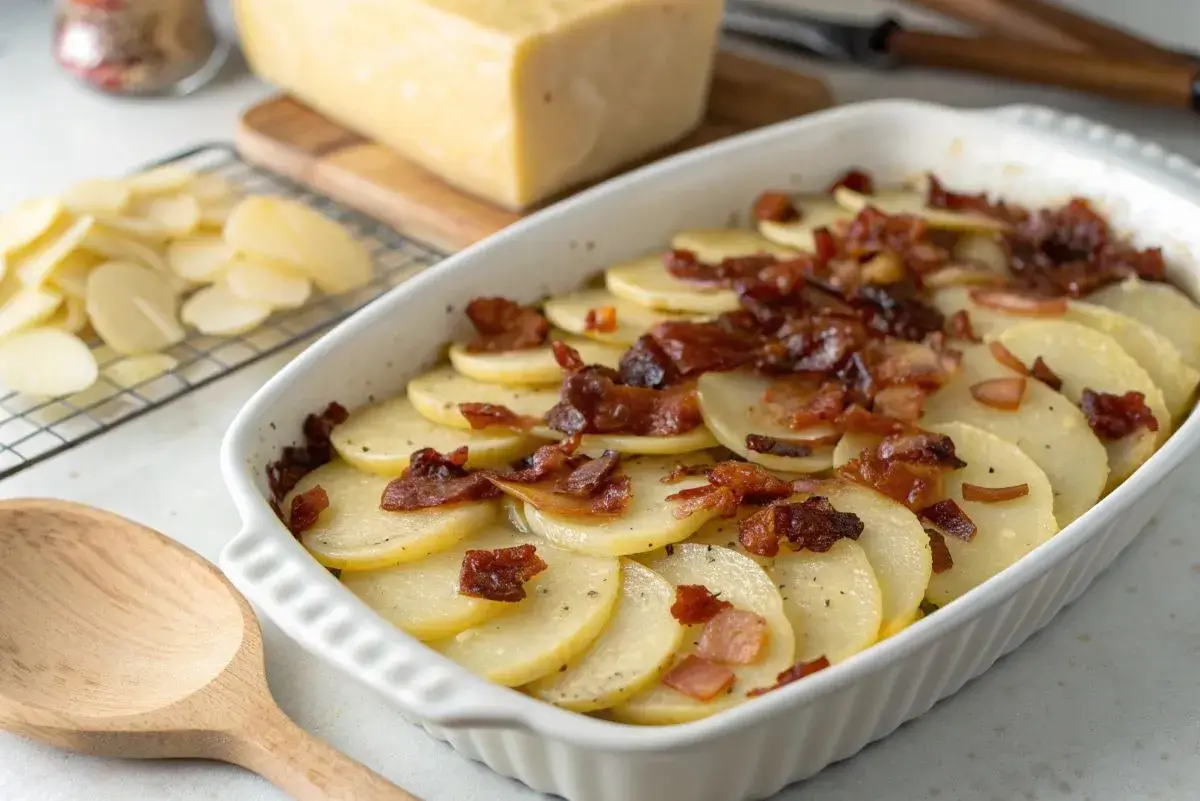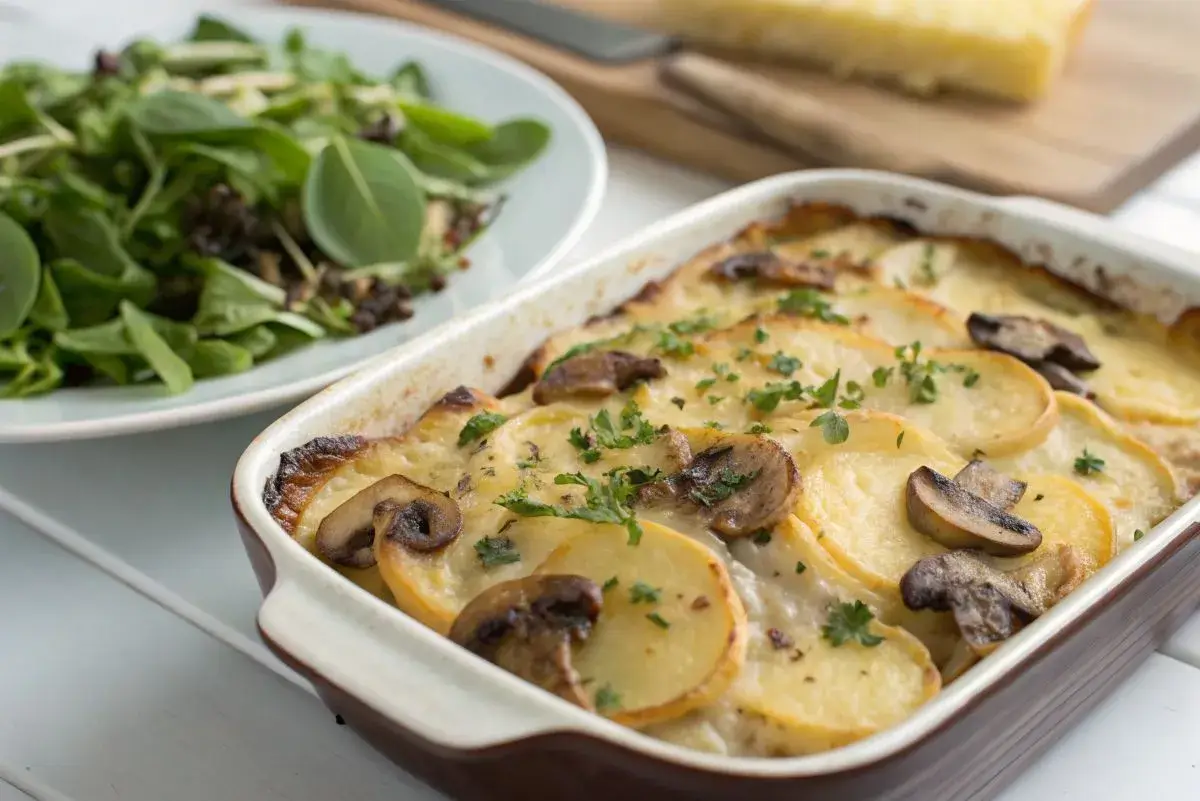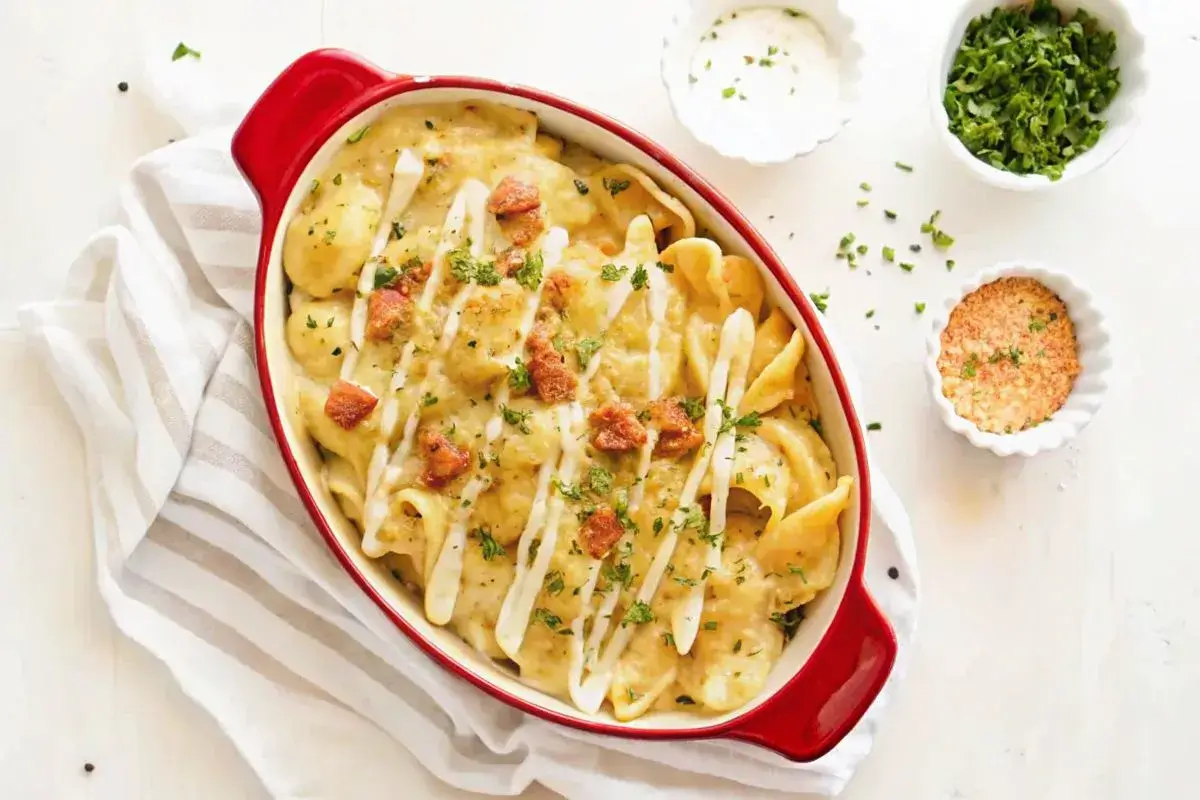Introduction
Anthony Bourdain, the iconic culinary storyteller, had a knack for uncovering the heart of authentic dishes. Among the many culinary gems he celebrated, the Tartiflette Recipe Anthony Bourdain is a standout, showcasing the indulgent simplicity of French Alpine cuisine. This dish, with its perfect harmony of creamy Reblochon cheese, tender potatoes, smoky bacon, and caramelized onions, is a warming embrace in every bite.
In this article, we’ll explore the Tartiflette Recipe Anthony Bourdain, diving deep into its origins, the ingredients that make it irresistible, and the step-by-step process to recreate it at home. From clever ingredient swaps to expert serving suggestions, you’ll find all you need to master this rustic French classic. So, let’s uncover the magic of tartiflette and its place in Bourdain’s world of bold flavors and unforgettable stories.
Introduction to Tartiflette and Anthony Bourdain’s Influence
The Origins of Tartiflette: A Traditional French Alpine Dish
Tartiflette hails from the picturesque Savoie region in the French Alps, known for its hearty, comforting dishes designed to fuel those braving the mountain cold. This rustic casserole was inspired by péla, an older recipe featuring potatoes, cheese, and onions. Tartiflette, however, elevates its predecessor with the addition of smoky lardons (bacon) and a creamy, gooey layer of Reblochon cheese.
Traditionally served as après-ski fare, tartiflette has become a symbol of Alpine hospitality. Its rich, cheesy goodness pairs perfectly with the chilled mountain air, making it a beloved dish in ski lodges and French homes alike.
Anthony Bourdain’s Appreciation for Tartiflette
Anthony Bourdain’s love for authentic, no-frills food often brought him to the heart of traditional cuisines. He championed dishes like tartiflette for their unapologetic richness and deep cultural roots. Bourdain once said, “Food is everything we are,” and tartiflette is a perfect example of a dish that tells a story of its people and place.
Known for diving into local culinary traditions with gusto, Bourdain likely relished the opportunity to indulge in this Alpine treasure. His celebration of such dishes inspired many food lovers to explore beyond mainstream recipes, embracing the bold and rustic flavors of regional fare.
The Significance of Tartiflette in French Cuisine
Though tartiflette’s origins are humble, its impact on French cuisine is undeniable. Beyond its popularity in Alpine regions, it has become a staple in winter gatherings, cozy family dinners, and even high-end restaurant menus. Its ability to bring people together around a shared love for comforting, satisfying flavors is what makes it so special.
If you’ve ever wondered about the magic behind Tartiflette Recipe Anthony Bourdain, you’re not alone. This dish encapsulates the culinary philosophy he adored: celebrating tradition, flavor, and the unpretentious joy of good food. In the next section, we’ll break down the ingredients that make this recipe truly unforgettable.
Understanding the Key Ingredients in Tartiflette
Potatoes: The Foundation of the Dish

Potatoes are the backbone of any good tartiflette. They provide the hearty base that supports the rich, cheesy layers above. For the Tartiflette Recipe Anthony Bourdain, waxy potatoes are your best bet. Varieties like Yukon Gold or Charlotte hold their shape well during cooking, ensuring each slice has the perfect bite.
When preparing the potatoes, the key is balance. You don’t want them too thick, as this could make the dish overly starchy. Thin, evenly sliced pieces allow the flavors of the cheese, bacon, and onions to meld beautifully. While boiling the potatoes beforehand is common, some prefer baking them for a firmer texture. Either way, the potatoes must absorb the rich juices from the other ingredients.
Reblochon Cheese: The Heart of Tartiflette
No discussion of tartiflette would be complete without Reblochon cheese. This creamy, nutty cheese is the star of the show, giving the dish its signature richness and velvety finish. Originating from the French Alps, Reblochon has a distinct aroma and a soft, melt-in-your-mouth texture that makes it irreplaceable.
However, if you can’t find authentic Reblochon, don’t worry. For those recreating Tartiflette Recipe Anthony Bourdain, substitutes like Brie, Camembert, or Raclette cheese can offer a similar creamy result. Just ensure the substitute you choose melts easily and has a mild, buttery flavor to complement the dish’s other components.
Bacon (Lardons): Adding Depth and Flavor
The smoky, savory element of tartiflette comes from lardons—small chunks of cured pork belly or thick-cut bacon. This ingredient not only adds a delightful chew but also infuses the potatoes and cheese with a salty richness. The fat rendered from the bacon creates a luscious base that coats every layer of the dish.
Anthony Bourdain’s take on tartiflette emphasizes simplicity, so sticking with high-quality bacon is crucial. Avoid overly processed options, and opt for thick-cut pieces with a good balance of fat and meat.
Onions and White Wine: Enhancing the Taste Profile
Caramelized onions are a subtle yet essential addition to this dish. Their natural sweetness balances the salty bacon and sharpness of the cheese, creating a harmonious blend of flavors. Slowly sautéing the onions until golden enhances their sweetness and adds a depth that elevates the entire dish.
White wine, often used to deglaze the pan after cooking the bacon and onions, introduces acidity and complexity to the recipe. For Tartiflette Recipe Anthony Bourdain, a dry, crisp wine like Sauvignon Blanc or Chardonnay is ideal. It cuts through the richness of the cheese and bacon, leaving a clean, balanced finish.
Step-by-Step Guide to Anthony Bourdain’s Tartiflette Recipe
Preparing the Potatoes: Selection and Cooking Methods
Start by selecting your potatoes. As mentioned earlier, waxy varieties like Yukon Gold work best for maintaining texture. Peel and slice them into thin, even rounds about 1/4 inch thick. Parboil the slices in salted water for 8–10 minutes until just tender but not fully cooked. This step ensures the potatoes finish cooking in the oven without becoming mushy.
Cooking the Bacon and Onions: Techniques for Optimal Flavor
In a large skillet, render the fat from the bacon or lardons over medium heat until they’re golden and crisp. Remove the bacon with a slotted spoon, leaving the flavorful fat behind. Add the sliced onions to the skillet and cook slowly, stirring occasionally, until caramelized. The goal is to achieve a deep golden hue without burning them.
Once the onions are caramelized, return the bacon to the skillet, stir everything together, and pour in the white wine. Let the mixture simmer for a few minutes, allowing the wine to reduce slightly and enhance the flavors.
Incorporating White Wine: Balancing Richness and Acidity
The addition of white wine at this stage deglazes the pan, lifting all those flavorful browned bits left behind from the bacon and onions. This step creates a rich, savory base that will seep into the potatoes as the tartiflette bakes. Be sure to let the wine reduce to avoid excess liquid in the final dish.
Assembling the Dish: Layering Ingredients for Perfect Consistency
To assemble, grease a baking dish with butter. Start with a layer of parboiled potatoes, followed by the bacon and onion mixture. Repeat these layers until all ingredients are used, ensuring the top layer consists of potatoes. Slice the Reblochon cheese in half horizontally and place the halves, rind-side up, on top of the final potato layer. The rind will create a golden, crispy crust as the cheese melts.
Baking to Perfection: Achieving the Ideal Texture and Appearance
Preheat your oven to 375°F (190°C). Bake the tartiflette uncovered for 25–30 minutes, or until the cheese is melted, bubbly, and golden brown. The edges should be slightly crispy, while the center remains creamy and indulgent.
Before serving, let the tartiflette rest for 5–10 minutes. This allows the layers to settle and makes slicing easier. Serve hot with a crisp green salad and a glass of white wine for a true French Alpine experience.

Alternative Ingredients and Variations
Reblochon cheese is the traditional choice for tartiflette, imparting a distinct creamy and nutty flavor. However, it’s not always easy to find. In such cases, suitable alternatives include:
- Taleggio: An Italian cheese with a strong aroma and a mild taste, it melts well, making it a good stand-in for Reblochon.
- Camembert: This soft, creamy cheese offers a similar texture and richness, blending seamlessly into the dish.
- Brie: With its buttery flavor and smooth consistency, Brie can effectively replace Reblochon in tartiflette.
When selecting a substitute, opt for a soft, washed-rind cow’s milk cheese that melts easily to maintain the dish’s authentic texture and taste.
Vegetarian Adaptations: Omitting Bacon Without Sacrificing Flavor
For those seeking a vegetarian version of the Tartiflette Recipe Anthony Bourdain, eliminating bacon is straightforward. To preserve the dish’s depth and smokiness, consider the following alternatives:
- Smoked Tofu: Cubed and sautéed, smoked tofu introduces a savory element reminiscent of bacon.
- Mushrooms: Varieties like shiitake or portobello, when sautéed until golden, add umami richness.
- Sun-Dried Tomatoes: Their concentrated flavor and chewy texture contribute complexity to the dish.

Incorporating these ingredients ensures the tartiflette remains hearty and satisfying without meat.
Incorporating Additional Elements: Mushrooms, Cream, and Herbs
While the classic tartiflette is cherished for its simplicity, adding certain ingredients can enhance its flavor profile:
- Mushrooms: Adding sautéed mushrooms introduces an earthy note that complements the creamy cheese and potatoes.
- Cream: A splash of heavy cream can make the dish even more indulgent, contributing to a luscious texture.
- Herbs: Fresh herbs like thyme or rosemary sprinkled on top before baking add aromatic complexity.
These variations allow for personalization while maintaining the essence of the traditional tartiflette.
Serving Suggestions and Pairings
Accompaniments: Salads and Side Dishes to Complement Tartiflette
Given the richness of tartiflette, pairing it with lighter sides creates a balanced meal. Consider serving it alongside:
- Mixed Green Salad: A simple salad with a tangy vinaigrette cuts through the dish’s creaminess, refreshing the palate.
- Steamed Vegetables: Lightly steamed greens like broccoli or green beans add a crisp texture and subtle flavor contrast.
- Pickles: Cornichons or pickled onions provide a sharp, acidic bite that complements the savory tartiflette.
These sides not only enhance the dining experience but also aid in digestion after a hearty meal.
Wine Pairings: Selecting the Perfect Beverage
Choosing the right wine elevates the enjoyment of tartiflette. Wines from the Savoie region naturally pair well, such as:
- Apremont: A dry, crisp white wine with floral notes that balance the dish’s richness.
- Roussette de Savoie: Offering a slight nuttiness, this wine complements the cheese’s flavor.
Alternatively, a light red wine like Pinot Noir can also harmonize with the dish’s components.
Occasions for Serving Tartiflette: From Family Dinners to Festive Gatherings
Tartiflette is versatile, suitable for various occasions:
- Family Dinners: Its comforting nature makes it a favorite for cozy evenings at home.
- Festive Gatherings: The dish’s communal aspect, often served directly from the baking dish, fosters a convivial atmosphere.
- Après-Ski Meals: Traditionally enjoyed after a day on the slopes, it provides warmth and sustenance.
Whenever served, tartiflette brings people together, embodying the spirit of shared enjoyment and hearty fare.
Frequently Asked Questions
What Is the Origin of Tartiflette?
Tartiflette traces its roots to the Savoie region in the French Alps. This hearty dish was inspired by an older recipe called péla, which featured a similar combination of potatoes, cheese, and onions. Tartiflette, however, became a culinary icon thanks to its inclusion of Reblochon cheese, adding a creamy, nutty richness that sets it apart.
Many people associate tartiflette with ski lodges, as it’s a popular après-ski meal that provides warmth and comfort after a day on the slopes. For fans of the Tartiflette Recipe Anthony Bourdain, understanding its history adds another layer of appreciation for this beloved dish.
Can I Prepare Tartiflette Ahead of Time?
Absolutely! Tartiflette is an excellent make-ahead dish. Assemble the layers in your baking dish, cover it tightly, and refrigerate for up to 24 hours before baking. When ready to serve, simply bake it as directed, adding a few extra minutes if it’s coming straight from the fridge.
This method is especially convenient for gatherings, allowing you to spend less time in the kitchen and more time with your guests. However, it’s best to bake tartiflette fresh if you want to preserve the gooey, melty perfection of Reblochon cheese.
What Are Suitable Substitutes for Reblochon Cheese?
If Reblochon is unavailable, there are plenty of substitutes that can achieve similar results. Brie, Camembert, or Raclette are all excellent options. These cheeses melt beautifully and provide a comparable creamy texture and flavor, making them ideal for the Tartiflette Recipe Anthony Bourdain.
How Do I Reheat Leftover Tartiflette?
To reheat tartiflette, preheat your oven to 350°F (175°C), cover the dish with foil, and bake for about 20 minutes. This ensures the cheese remains creamy without overcooking the potatoes. For smaller portions, reheating in the microwave on low power works as well.
Conclusion: Embracing the Richness of Tartiflette
The Cultural Importance of Tartiflette in French Alpine Regions
Tartiflette is more than just a dish—it’s a cultural emblem of French Alpine cuisine. Rooted in tradition, it brings together simple ingredients to create something deeply satisfying and universally loved. Its enduring popularity reflects the French commitment to celebrating comfort and flavor in every meal.
Anthony Bourdain’s Legacy and His Love for Traditional Dishes
Anthony Bourdain’s fascination with authentic culinary experiences brought dishes like tartiflette into the spotlight. Known for his passion for unpretentious, rustic food, he admired how tartiflette embodied the heart of its region. By recreating the Tartiflette Recipe Anthony Bourdain, you’re not just cooking a meal—you’re connecting with a story that celebrates simplicity, bold flavors, and shared traditions.
Encouragement to Explore and Enjoy Tartiflette at Home
Whether you’re an experienced cook or a curious beginner, tartiflette is a dish that welcomes all. With its straightforward preparation and indulgent flavors, it’s a crowd-pleaser that suits any occasion. So grab some Reblochon (or a suitable substitute), slice those potatoes, and let the aroma of bubbling cheese fill your kitchen.
In the spirit of Bourdain, don’t just enjoy the food—embrace the story behind it. Share it with loved ones, pair it with a crisp wine, and savor the comfort of this Alpine classic.
Additional Resources and Inspiration
Discover More Recipes Inspired by Anthony Bourdain
Anthony Bourdain’s travels introduced the world to countless dishes, each with a rich history and cultural significance. If the Tartiflette Recipe Anthony Bourdain has sparked your interest in authentic culinary adventures, there’s a treasure trove of other recipes to explore. From French onion soup to coq au vin, Bourdain’s appreciation for rustic and flavorful cuisine offers endless inspiration.
For those who love the hearty simplicity of tartiflette, dishes like gratins, casseroles, or Alpine-inspired comfort foods might be your next favorite. They capture the same essence of warmth and indulgence, making them ideal for family gatherings or cozy evenings.Food & Wine
Encouraging Culinary Exploration and Experimentation
Cooking isn’t just about following a recipe—it’s about embracing creativity and making a dish your own. While the traditional tartiflette holds a timeless charm, don’t hesitate to experiment. Try using different cheeses, add a dash of spice, or pair it with unexpected sides to make it uniquely yours.
Bourdain often encouraged cooks to step out of their comfort zones, explore new flavors, and appreciate the stories behind each meal. When you dive into recipes like this one, you’re continuing that legacy of discovery and connection.
For more culinary ideas, consider exploring recipe guides that focus on traditional French dishes or global comfort foods.
Final Thoughts: Why Tartiflette Deserves a Place on Your Table
The Timeless Appeal of Tartiflette
Tartiflette is more than just a dish—it’s an experience. Its creamy layers of Reblochon, tender potatoes, and smoky bacon bring a sense of nostalgia and comfort that few recipes can match. Whether enjoyed in a cozy mountain chalet or recreated in your kitchen, it’s a meal that brings people together.
The Tartiflette Recipe Anthony Bourdain captures this essence perfectly. By celebrating its rustic roots and focusing on the simplicity of its ingredients, Bourdain reminds us that great food doesn’t have to be complicated. It’s about honoring the dish, its culture, and the people who’ve enjoyed it for generations.
Bringing the Spirit of Bourdain into Your Kitchen
Cooking this dish isn’t just about making something delicious—it’s about connecting with a rich culinary tradition and carrying on Anthony Bourdain’s love for authentic, unpretentious food. When you serve tartiflette, you’re sharing more than a meal; you’re sharing a story that transcends time and place.
So, whether you’re preparing this dish for the first time or it’s already a family favorite, embrace its hearty flavors and cultural roots. Pair it with a good wine, surround yourself with loved ones, and celebrate the joy of a meal that’s both simple and extraordinary.

